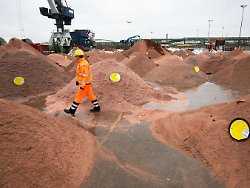Increased demand due to energy transition
Metal bottlenecks can only be overcome with recycling
04/25/2022, 12:58 p.m
According to a study, significantly more metals will be needed in the EU in the coming years due to the expansion of e-mobility and the conversion of the energy industry to renewables. If the continent does not want to make itself dependent on Russia or China, more determined recycling is the only solution.
According to an investigation, the EU is threatened with medium-term bottlenecks in the supply of metals such as lithium. The background is that the demand for raw materials will increase sharply, for example in order to make the energy industry and transport sustainable, according to a study by the Catholic University of Leuven in Belgium. “Electric vehicles, batteries, photovoltaic systems, wind turbines and hydrogen technologies all require significantly more metals than their traditional alternatives,” the researchers said. The study was commissioned by the European association Eurometaux, which brings together non-ferrous metal producers and recyclers.
According to the study, the global energy transition is progressing faster than the number of mining projects to extract the necessary metals. For copper, cobalt, lithium, nickel and so-called rare earths, there could therefore be global supply bottlenecks from 2030. Europe only has a small window of opportunity to boost its domestic production. From 2040 onwards, a large part of Europe’s metal requirements could also be covered by recycling.
“Recycling is Europe’s biggest way to improve its long-term self-sufficiency and could meet 45 to 65 percent of Europe’s base metal needs by 2050,” it said. With so-called rare earths and lithium there is the potential to achieve quotas of more than 75 percent.
Rare earths come from China and Russia
According to the study, the demand for lithium is increasing by far the most. Global demand for the metal as a transitional commodity by 2050 is expected to be more than 2,000 percent of 2020 total global demand. But also for rare earths such as dysprosium (up 433 percent) or the heavy metal cobalt (up 403 percent), according to the information, a significantly higher demand can be expected. Looking at Europe, the researchers calculate that 35 times more lithium, 7 to 26 times more rare earth metals and 3.5 times more cobalt will be needed to generate energy sustainably and make the EU climate-neutral by 2050 .
The rare earth metals, which in Germany have so far mainly come from China, but also from Russia, have special properties, for example as superconductors, or have a special heat resistance that makes them valuable for industry. They are used, among other things, in computer components, but also in camera lenses, in magnets for wind power generators or electric cars.
For now, the EU remains dependent on imports for most of these metals, while concerns about security of supply are growing. “Europe urgently needs to decide how to bridge its looming primary metal supply gap,” said study author Liesbet Gregoir. “Without a determined strategy, it risks new dependencies on unsustainable suppliers,” she warned.
“Without an early supply of new primary metals and better recycling, there is a risk of critical bottlenecks that endanger Europe’s goal of a more autonomous, clean energy system,” said the KU Löwen. However, the study is limited by the fact that technological developments and changes in behavior can still influence the situation, but were not taken into account in the study.
